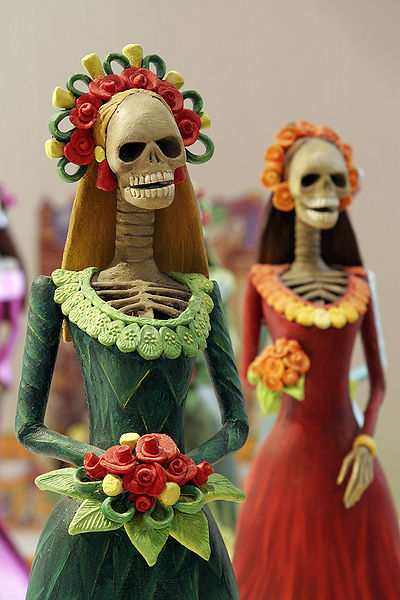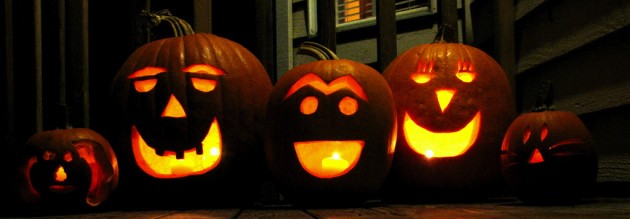Halloween Throughout the Ages
Halloween, one of civilization’s truly great holidays, is a celebration of the macabre and the otherworldly going back thousands of years to Celtic pagan traditions. Halloween, as everyone known, is a magical day where you can dress up in strange costumes, watch scary movies, and, depending on your age bracket, either get free candy or attend wild parties. The name Halloween (or Hallowe’en, as it is more accurately spelled in Canada and the British Isles), dates back to 1745, and is a contraction of the Scottish term “All Hallows’ Even,” meaning the night before All Hallows’ or All Saints’ Day (November 1st), a Church holiday dedicated to honoring the saints.
While the full name of “All Hallows’ Day” can be traced back to the Old English ealra hālgena mæssedæg, meaning “mass-day of all saints,” the original incarnation of Halloween was Samhain (pronounced SOW-in,) a festival celebrating the end of the harvest season and the oncoming of the dark winter months in Ireland, Scotland, and the Isle of Mann. (Other Celtic cultures had their own versions of Samhain, such as Calan Gaeaf in Wales, Kalan Gwav in Cornwall, and Kalan Goañv in Brittany.) The name is thought to literally mean “summer’s end,” from the Old Irish sam (summer) and fuin (end).
It was believed that at this time of the year, the veil between the mortal and spirit realms was at its thinnest, and beings such as fairies—known in Irish folklore as the Sidhe, who were mischievous at best and often downright sinister and murderous—and other spirits had free reign of the physical world. To appease the Sidhe, as well as welcome any visiting dead spirits, people left offerings of food and drink, lit bonfires, and performed cleansing rituals to keep them safe until spring. The tradition of mumming in Ireland, Scotland, and the Isle of Mann, involved disguising oneself in costumes or painted faces to trick the Sidhe and go from door to door singing in exchange for food. This, of course, evolved into the modern tradition of trick-or-treating.
When Christianity conquered the Celtic regions, Pope Gregory IV decided to revamp the Church calendar to align with the pagan calendar, just to make it easier to convert the locals. As such, the Feast of All Hallows’ was switched from May 13th to November 1st. Many pagan traditions were retained and new ones were formed. The iconic jack-o’-lantern comes from an Irish legend about Jack, a man whose soul was too wicked for Heaven or Hell. When he dies, Satan throws a burning coal at him, and Jack traps it in a hollowed out turnip. Since then, his spirit has been roaming the earth with his makeshift lantern, looking for a place that will accept him. In Ireland and Scotland, carved turnips or beets with candles inside were known as “mangelwurzels,” but when the tradition moved to North America, colonists started using pumpkins instead, which we now call “jack-o’-lanterns.”
 As the tradition of All Hallows’ Eve spread to the New World as well as Protestant Europe, different countries began to put their own spin on it. Lutheran churches in Germany came up with Totensonntag, or “Sunday of the Dead,” also known as Ewigkeitssonntag, or “Eternity Sunday,” which is the last Sunday before Advent, set aside as a day to remember and pray for dead souls. And then, famously, there is the Latin American Día de los Muertos (Day of the Dead,) which lasts from October 31st to November 2nd, in which families honor their dead family members by building altars over their gravesites and offering up flamboyant sugar skulls, marigolds, food, and drink. Modern traditions are influenced by the century-old festival of Mictecacihuatl, the Aztec goddess of the underworld, known as the Lady of the Dead, now represented by La Calavera Catrina, or “the Dapper Skeleton,” a ubiquitous image of a skeleton dressed up in an elegant dress and floral tiara.
As the tradition of All Hallows’ Eve spread to the New World as well as Protestant Europe, different countries began to put their own spin on it. Lutheran churches in Germany came up with Totensonntag, or “Sunday of the Dead,” also known as Ewigkeitssonntag, or “Eternity Sunday,” which is the last Sunday before Advent, set aside as a day to remember and pray for dead souls. And then, famously, there is the Latin American Día de los Muertos (Day of the Dead,) which lasts from October 31st to November 2nd, in which families honor their dead family members by building altars over their gravesites and offering up flamboyant sugar skulls, marigolds, food, and drink. Modern traditions are influenced by the century-old festival of Mictecacihuatl, the Aztec goddess of the underworld, known as the Lady of the Dead, now represented by La Calavera Catrina, or “the Dapper Skeleton,” a ubiquitous image of a skeleton dressed up in an elegant dress and floral tiara.
Dating back thousands of years to pre-Christian civilizations, Halloween has proved itself one of humanity’s most versatile and enjoyable celebrations. And as long as people have deceased relatives to honor or ghost stories to tell, it will continue to exist in some form all around the world. What’s your favorite version of Halloween?

